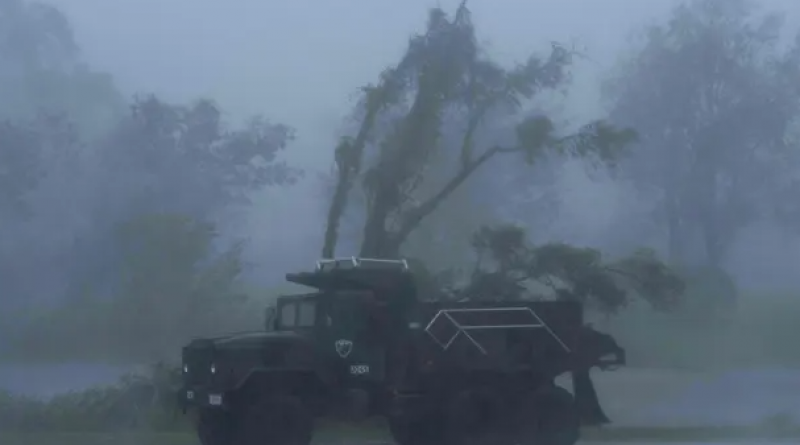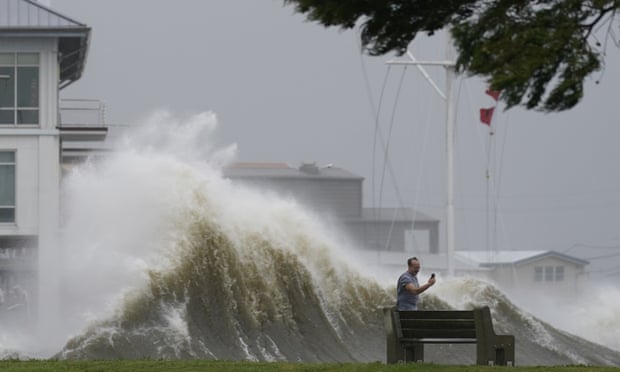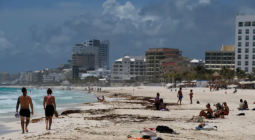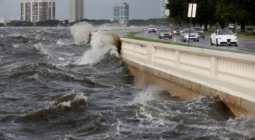Hurricane Ida: New Orleans loses power as category 4 storm hits

Hurricane Ida has knocked out power in New Orleans after making landfall in Louisiana as a brutal category 4 storm, slamming the coast with 150mph sustained winds.
One of the most powerful storms to hit the US, Ida caused “catastrophic transmission damage” to energy supplier Entergy’s facilities on Sunday night, plunging the city into darkness.
The force of the storm reversed the flow of the Mississippi River and the National Weather Service soon issued flash flood warnings just outside New Orleans.
Ida had made landfall on Sunday morning at the southern tip of Lafourche parish, at Port Fourchon. It was the 16th anniversary of Hurricane Katrina, the catastrophic hurricane that killed more than 1,800 on the Gulf coast in 2005.
As Ida moved inland it remained at category 4 strength but dropped sustained winds to 140mph. Ominously, it was slowing down, moving north-west at just 10mph according to the National Hurricane Center (NHC). Slow-moving storms can lead to significantly more devastation.
Louisiana began experiencing mass power outages. More than 400,000 households were without power by mid-afternoon. New Orleans was experiencing hurricane-force wind gusts as the storm inched its way closer. There were reports of downed trees, roofs blown away and a large passenger ferry drifting in the Mississippi River.
The Louisiana governor, John Bell Edwards, said Ida was following close to “the worst possible path”.
“This is not the kind of storm that we normally get,” he told the Associated Press. “This is going to be much stronger than we usually see and, quite frankly, if you had to draw up the worst possible path for a hurricane in Louisiana, it would be something very, very close to what we’re seeing.”
After approving federal disaster declarations for Louisiana and Mississippi on Saturday, Joe Biden appeared at Federal Emergency Management Agency (Fema) headquarters in Washington on Sunday afternoon.
“As soon as the storm passes we’re going to put the country’s full might behind the rescue and recovery,” he told reporters.
Fema said the full impact of Ida would not be known until Monday.

Although Ida arrived with more powerful winds and expected rainfall than Katrina, forecast storm surge of a life-threatening 15ft was expected to be less than in 2005 when Katrina brought highs of 20ft, leading to catastrophic failure of levees in New Orleans.
Appearing on CNN, Edwards said he was confident the levees would hold.
“There’s been tremendous investment in this system since Hurricane Katrina,” he said. “This will be the most severe test of that system. But we believe that system is going to hold, the entire integrity of that system will be able to withstand the storm surge.”
On Saturday Edwards warned that Ida was likely to be one of the most severe hurricanes in the history of Louisiana, which is known for torrid weather events.
“This will be one of the strongest hurricanes to hit anywhere in Louisiana since at least the 1850s,” he said. “We can also tell you your window of time is closing. It is rapidly closing.”
Tens of thousands of residents in coastal communities were under mandatory evacuation orders. In New Orleans, those outside the levee protection system were under mandatory evacuation and all others were urged to leave voluntarily. There was gridlock on the main highway leaving the city on Saturday and vast queues at the Louis Armstrong international airport, as all flights were cancelled on Sunday.
On Sunday a tornado watch was issued until 7pm in New Orleans and a number of surrounding parishes. Tornado watches were in place in coastal Mississippi and Alabama as well.
Speaking to CBS, Edwards said: “We think an awful lot of people did evacuate, but this is a very difficult storm. It’s going to come in with sustained winds of over 150mph, when you get to a category 5 storm at 157mph. So, there’s virtually no difference between a very, very strong cat 4 or a cat 5 storm. And so we’re absolutely doing everything that we can now to get people to take those last-minute steps.”

It was 29 August 2005 when New Orleans and other communities were devastated by Katrina and government failures in response. Hundreds of thousands of homes were lost in catastrophic flooding. New Orleans took years to recover.
Downtown on Saturday evening, streets were eerily quiet. In the historic French Quarter, businesses were boarded up. Bourbon St, usually the centre of nightlife, was deserted.
Still, some businesses remained open. At Buffa’s, a 24-hour dive bar and jazz venue in the Marigny neighborhood known for staying open during inclement weather, regulars came to drink and eat.
Aha Hasan, a 25-year-old camera technician, sipped beer and drank shots before preparing to ride out the storm at his nearby third-floor apartment. He was 10 when Katrina hit and remembers it vividly.
“Every four years we get a bad one,” he said. “And everyone I know who’s been in this city for all these intense hurricanes aren’t going anywhere this time, so I decided to stay because of that.”

The Louisiana national guard had stationed 5,000 troops in preparation for search and rescue missions. For power outages, 10,000 linesmen were placed on standby.
Hospitals in Louisiana are packed with patients from the latest coronavirus surge. Jennifer Avegno, the top health official for New Orleans, warning residents to prepare for the storm as well as further Covid-19 spread.
Louisiana has not been able to evacuate hospitals as hospitals in neighbouring states are also at capacity due to the pandemic. Around 20 nursing homes and rehabilitation facilities had been evacuated, Edwards said on Sunday.
The storm also threatened oil and petrochemical facilities lining the Mississippi River between New Orleans and Baton Rouge. The area, known locally as “Cancer Alley”, is home to more than 100 plants in low-lying areas which are vulnerable to flooding.
Research has shown that the climate crisis is contributing to more frequent and more ferocious hurricanes, as rising ocean temperatures provide fuel for storms.
The arrival of Ida marked the first time Louisiana had experienced a hurricane with 150mph winds in consecutive years, after Laura last August. The only other storm with such winds to hit the state landed in 1856.
30 August 2021
The Guardian





